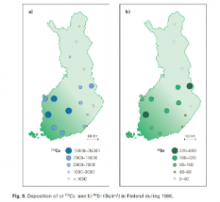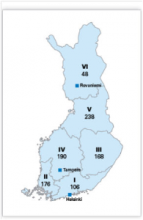Finnish deposition monitoring data
 |  |
| Abstract | The measurement of deposited radionuclides (wet + dry) in Finland started in 1961 with 17 stations. The current sampling network consists of 9 stations. The sampling period is one month, but more frequent sampling was carried out following the Chernobyl and Fukushima accident. The radionuclides that have been analysed include 137Cs, other gamma nuclides and 90Sr. Prior to the Chernobyl accident samples from different stations were pooled and analyzed as one sample, representing the fallout level for the whole county. After the Chernobyl accident, the samples were analysed separately for each station. At one station (Helsinki) dry and wet deposition have also been determined separately since 1993 for 137Cs and 7Be. | |
| STAR partner | STUK | |
| Type of data | Monitoring | |
| Sample number | >1000 | |
| Quality | Data have been collected as a part of STUK’s environmental monitoring program since 1961. Since 1999, radioactivity determinations have been carried out using an accredited method with regular quality control through intercomparisons, calibrations and blank samples. Prior to 1999, in-house quality evaluation took place with similar quality assessments. Locations are currently recorded by name of the city where deposition has been collected. | |
| Spatially referenced | Spatial reference can be provided also as latitude/longitude (KKJ coordinates). | |
| Ecosystem type | Terrestrial | |
| Sample type | Deposition data (wet & dry) | |
| Date | 1961 - ongoing | |
| Languages | Finnish | |
| Status | On-going programme | |
| Obtain data | Data are provided on request without restriction. Contact: star.stuk@stuk.fi | |
| Key reference sources | ||
| Data ownership | STUK | |
| Database format | Excel | |
| Figure information | 1) Deposition of 137Cs and 90Sr in Finland during 1986 2) Sampling sites and regions for diet samples in Finland (Figures supplied by STUK) | |
| Keywords | chernobyl , fukushima , finland , nuclear_weapons_fallout , infoex | |
Prepared by STAR NoE
